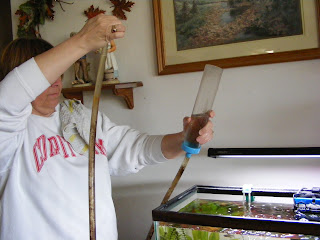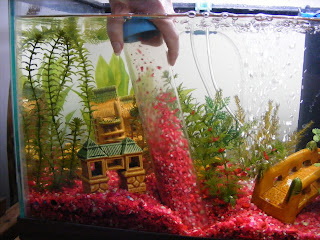If you've kept up with my blog from beginning to end you might remember hearing about S.D. my silver angelfish that I bought last summer with my mom. When we bought S.D. he was about an inch tall from fin tip to fin tip. Now he spans about the width of my fingers, about 3.5in. I can hardly believe how big he's grown.
Growing fish is always an aqaurists entertainment, however when your fish outgrow your tank it becomes a problem. With Angelfish its easy to tell when they need a new crib so to speak. The bottom fin starts to curl up. If they can't be placed in a larger tank, usually just taller, then this curling of the fin will become permanent.
Angelfish can grow to be about 12inch tall, and come from the Cichlidae family of fish. Angelfish are often available with stripes running vertically down their body. Marble Angelfish are also available, with a splash of colors. They tend to be a predator type of fish, S.D. chases the tiger barbs, and zebra danios that we have all the time.
One thing you should remember when thinking about an Angelfish are the type of fish you already have or may want. Due to the long flowing fins that Angelfish have, any aggressive tankmates may be inclined to nip their fins, you must keep this in mind when picking future fish.
You must also be willing to purchase more than one Angelfish. This is due to the fact that they form long-term relationships where each individual will protect the other from threats and potential suitors. Breeders have experienced the remaining mate rejecting and or refusing to pair up with any other angelfish, after the death or removal of their mate.
April 26, 2011
April 10, 2011
Spring Cleaning Round Two
In case you didn't know, having an aqaurium with a filter does not excuse you from the responsibility of changing the water. Most goldfsih bowl owners know this is a basic for keeping fish. It's the same with a tank or aquarium that has a filter, or an algae eater, the water still should be changed periodically to keep the tank fresh and smelling clean.
After you have vaccumed your tank, you will need to put new treated water back into the tank to replace the amount you took out while cleaning it.
Here's how you should start. The water you pour into your bucket should be an apporpriate temperature. Remember you don't want to shock your fish with a drastic temp change, so run a thermometer under the water. When the temp is just right for the type of fish you have, and only 1-5 degrees different than the water already in the tank, fill up the bucket.
After you have vaccumed your tank, you will need to put new treated water back into the tank to replace the amount you took out while cleaning it.
Here's how you should start. The water you pour into your bucket should be an apporpriate temperature. Remember you don't want to shock your fish with a drastic temp change, so run a thermometer under the water. When the temp is just right for the type of fish you have, and only 1-5 degrees different than the water already in the tank, fill up the bucket.
The next step after getting water at the right temperature is to treat it. Untreated water could harm your tank environment. You don't want to have difficulties with Nitrates, and your pH balance should be very similar to the pH balance of the water in your tank.
You can use a standard Start Right disk, or liqiud. There are also perfect pH tablets available. Place these into your 'new' water. After these items dissolve you can pour the treated water into your fish tank.
You should also pour a few drops of 'Stress Coat' in the tank so that your fish are calm and won't freak out while the tank itself is adjusting to the new water.
April 4, 2011
Spring Cleaning
Now that spring has sprung I thought it would be a decent time to explain how to clean your fish tank. Yes, you have to clean your fish tank.
First your going to need a few items, if you don't already have them, here are a few of my choices.
 To do this, you should place the tube end of your vaccum hose into the tank, like the picture on the left. You should only insert the tube into the top of the tank, make sure you don't have any fish go inside of it.
To do this, you should place the tube end of your vaccum hose into the tank, like the picture on the left. You should only insert the tube into the top of the tank, make sure you don't have any fish go inside of it.
You should be able to see the dirt move, as well as the gravel should be stirred up also.
If you have small fish you should be especially carefull and keep your eyes open to make sure that you don't suck them up accidentally.
Continue to siphon out the tank until you have taken about 1/4 of the water from the tank out.
I will continue on the next post on how to fill the tank back up properly.
First your going to need a few items, if you don't already have them, here are a few of my choices.
Fluval 11059 Edge Gravel Cleaner Hagen Gravel Vaccum
Available at Amazon.com
Available at Petsmart.com
The next item you will need, is a large bucket of some description. The most important thing to remember is to make sure this is your 'fish bucket'. Food containers are great to use because they won't have any elements leftover in the bucket that could potentially contaminate the water, and thereby causing the fish harm. Make absolutely certain, any liquids such as bleach, or vinegar, anything that would harm your fish, hasn't been in the bucket you plan to use as your 'fish bucket'. This is crucial.
Now that you have the proper tools you are ready to begin cleaning your fish tank.
First you need to create the suction so that you can suck the dirt out of the gravel.
 To do this, you should place the tube end of your vaccum hose into the tank, like the picture on the left. You should only insert the tube into the top of the tank, make sure you don't have any fish go inside of it.
To do this, you should place the tube end of your vaccum hose into the tank, like the picture on the left. You should only insert the tube into the top of the tank, make sure you don't have any fish go inside of it.Lift the tube out of the tank, make sure you have a decent amount of water inside. The water should trickle down the hose.
Begin moving the water so that it wants to go down the hose, but keep the other end lifted up high so that it doesn't leave the hose yet. Remember you are trying to create a suction. This is really much simpler than it appears. It just takes alot of practice.
Continue this process, until you think you have a decent amount of water.
Once you can place the hose into your bucket, and keep the tube in the fish tank your suction has been created. Your vaccum will continue to siphon water out of the fish tank. Now you can begin cleaning!
.
You should move your vaccum tube around the tank carefully keeping the edges of the tube in the gravel so that the water taken out is also removing dirt buildup in the bottom of your tank
You should be able to see the dirt move, as well as the gravel should be stirred up also.

If you have small fish you should be especially carefull and keep your eyes open to make sure that you don't suck them up accidentally.
Continue to siphon out the tank until you have taken about 1/4 of the water from the tank out.
I will continue on the next post on how to fill the tank back up properly.
Subscribe to:
Comments (Atom)













